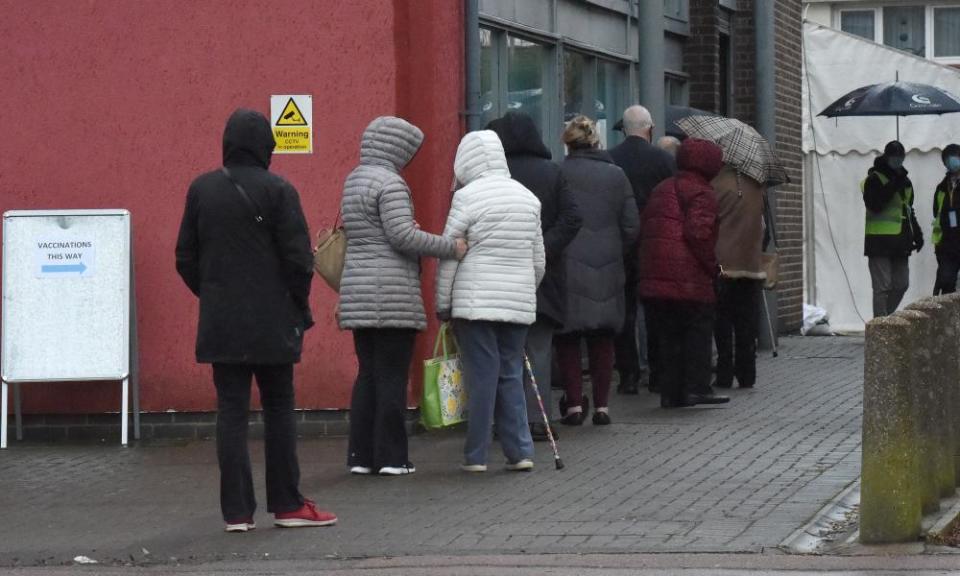Concern over 'worrying' disparities in Covid vaccine coverage in England

Doctors have raised concerns about “worrying” disparities in vaccine coverage in England amid signs black people and those in more deprived areas were less likely to receive the vaccine than others in the first weeks of rollout.
Researchers monitored the vaccination status of more than 1 million people aged 80 and over from the start of the vaccination programme on 8 December and found 41.1% had received at least one shot by 13 January. None of the patients in the study were living in care homes.
But the rapid assessment of the deployment revealed vaccine coverage was twice as high among white people than black people in the first five weeks, with 42.5% of white people receiving the jab compared with 20.5% of black people in the group. The vaccination status of south Asian people was also a concern at 29.5%, doctors said.
The government’s joint committee on vaccination and immunisation has published a list of groups of people who will be prioritised to receive a vaccine for Covid-19 in the UK. The list is:
1 All those 80 years of age and over and health and social care workers.
2 All those 75 and over.
3 All those 70 and over.
4 All those 65 and over.
5 Adults under 65 at high at risk of serious disease and mortality from Covid-19.
6 Adults under 65 at moderate risk of at risk of serious disease and mortality from Covid-19.
7 All those 60 and over.
8 All those 55 and over.
9 All those 50 and over.
10 Rest of the population.
“These are preliminary findings but they do suggest worrying patterns, and they are particularly worrying because the groups that are getting lower coverage are those most at risk of bad outcomes,” said Liam Smeeth, a professor of clinical epidemiology at the London School of Hygiene & Tropical Medicine (LSHTM). “The rollout of the vaccine is a work in progress, but if these patterns are seen once the programme is much more mature they would be very worrying indeed.”
The analysis by researchers at the University of Oxford’s DataLab and LSHTM used a platform called OpenSAFELY, which allows secure studies to be done on electronic NHS health records. It found further disparities in vaccine uptake at least in the early stages of distribution. Vaccination rates in the most well-off areas were 44.7% in the first five weeks, compared with 37.9% in the most deprived areas, with lower rates among people with severe mental illness (30.3%), dementia (30.9%) and learning disabilities (28.1%).
Writing in the study, which is yet to be peer-reviewed, the researchers describe how many different factors can affect vaccine coverage and that rates could change rapidly as the programme continues.
Stephen Evans, a professor of pharmacoepidemiology at LSHTM, said there were greater disparities in the first weeks of the programme when only Pfizer shots were available. Many GP surgeries could not provide the Pfizer vaccine because it requires ultra-cold storage, meaning it was given mostly from hospitals. “Access was at first a key factor,” he said. “That is changing very rapidly, and we are seeing possibly less variation as the rollout of the AstraZeneca vaccine does not have the cold chain requirements.”
default
Another factor may be a greater reluctance to get vaccinated, with research in January suggesting high rates of vaccine hesitancy, of more than 70% among black people, nearly three times higher than among white people.
“We have to make sure we’re taking steps to ensure poorer areas are getting good vaccine rollout and that we’re aware of vaccine hesitancy,” said Smeeth. “There is going to be a need for information, reassurance and encouragement in those groups and we need to make sure we’re reaching people with illnesses, those who are housebound, and those with learning disabilities. The people who perhaps have most to gain from vaccination will often be the hardest to reach for a range of reasons, so extra efforts are going to need to be made.”
Evans said it was vital people did not let their guard down after receiving the vaccine. “I am worried that a few days after getting a jab, people will indulge in more risky behaviours. This may get worse as those younger than 80 get vaccinated. Even a month after vaccination, there is no guarantee of protection for the individual and those around them.
“No vaccine is 100% protective, so doing all we can to avoid transmitting the virus is so important. This will need to continue until we know that there is very little virus around and that will take months.”

 Yahoo Finance
Yahoo Finance 